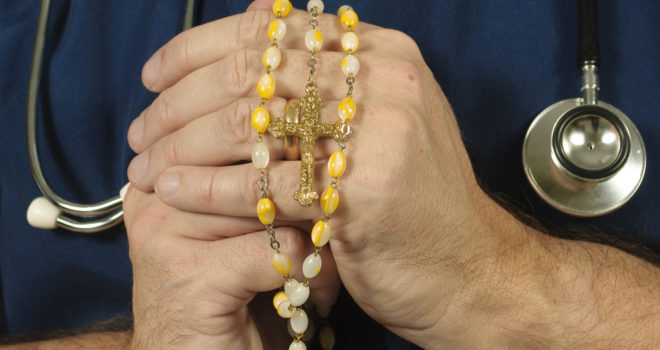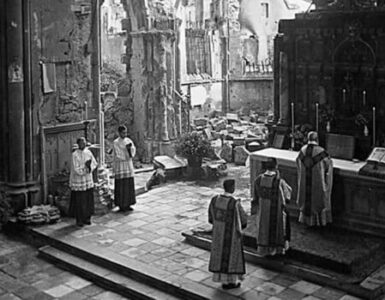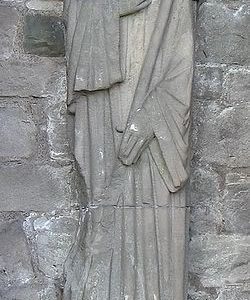It’s National Nurses Week, which concludes on May 12, Florence Nightingale’s birthday. The following reflection is adapted from a speech Rick Becker gave to Bethel College nursing graduates last Saturday (May 4) at their Pinning ceremony .
It’s a gross oversimplification, and it’s even frowned upon in medical training circles today, but there’s still a lot of truth in the old nursing adage: See one, do one, teach one.
For example: Think back to when you learned to give injections.
Probably, it was something utterly foreign to your experience and, frankly, terrifying — sticking a total stranger with a sharp object, let alone pushing chemicals into his arm! But we talked about it in the lab, we showed you videos, we demonstrated it (on manikins, of course) — you saw how we did it, and you heard us insist that you could do it, too.
Then, after seeing, you did it yourself — that same day, right there in the lab! You drew up some saline in a syringe, you swabbed off a practice pad, and you got up to courage to jab it in – success! You kept at it, over and over and over, until you could do it without breaking into a cold sweat, and you were ready for the inevitable, ominous-sounding check-off — in nursing school, the main way you follow “see one” and “do one” with “teach one.”
In a sense, you were teaching back to us what you’d learned and practiced, and then you went on teaching back to us as you performed those skills in the clinical setting on real patients. Many of your other nursing skills were reinforced the same way: You’d encounter the new skill, then practice it yourself, and finally turn around and share what you’d encountered and assimilated.
Here’s the thing, though: Nursing isn’t just about those bedside skills — not even close. Especially for Christian nurses. It’s also about your presence and attention; it’s about how you do things, not just what you do; it’s about being a conduit of God’s healing and comfort through your words, through your gestures, through your prayers, both spoken and silent.
It’s about, in other words, being ambassadors of Jesus – his envoys in the lives of those who are sick and suffering, apprehensive and forlorn.
This is at the heart of a Biblical vision for nursing, and I’d like to cap off your nursing formation by presenting a few exemplars of this Biblical vision that I hope you’ll keep in mind as you launch your career. And I’ve made it easy for you to remember them — in a word, Mary. Actually, make that Mary times three.
The first is the Mary you’re probably thinking of — the Christmas Mary, the virgin mother of the Messiah. We see in the beginning of Luke’s Gospel that Mary sees or encounters divine grace the moment the angel Gabriel tells her that she’s to be the mother of Jesus – “Let it be to me according to your word,” is her verbal response.
Immediately after, however, she follows up with an active response — seeing is followed by doing — and she visits Elizabeth, herself 3 months pregnant with John the Baptist. Mary, having received Jesus, literally, in the flesh, turns around and brings Jesus (again, literally) to her expectant cousin — the best pre-natal home visit ever!
That’s what we get to do as well — what you’ve been doing as a student nurse, and what you’ll be doing every day as an RN: Bringing Jesus to others through your skills, your knowledge, your presence, yourselves. And when others praise you for your selflessness and care, you’ll point to God – teaching through your words and example that what you do is all about whom you have received, just as Mary does with Elizabeth. “My soul magnifies the Lord,” she tells her cousin. “My spirit rejoices in God my Savior.”
The second Biblical nursing Mary is the Mary of Bethany, the sister of Martha and Lazarus. These three siblings were clearly the Lord’s chums, which means they’d already seen who he was — or, in my terminology, they’d already encountered his Gospel of love. In Luke, we also see Mary and Martha doing the Gospel they’d encountered by offering hospitality to Jesus, but in two very distinct ways that mirror the two dimensions of our profession. There’s the Martha of Bethany in us which is oriented to tasks – and which, frankly, is what our employers expect of us, not to mention our patients. But we’re also called, again especially as Christian nurses, to do a lot of Mary of Bethany at the bedside — sitting at the feet of Jesus under the guise of the sick, listening, just being with.
Mary and Martha also appear late in John’s Gospel, caring for their ailing brother, Lazarus, and advocating for his healing by sending for Jesus. Although Lazarus dies before Jesus arrives, we see the two sisters persisting in their advocacy — a teach-back of total faith in Christ, who assures them that “whoever lives and believes in me shall never die.” Jesus then goes on to raise Lazarus from the dead, anticipating his own resurrection, but also affirming with action the two sisters’ declaration of faith.
Finally, we have Mary Magdalene, a prominent New Testament figure, and a witness to both the crucifixion and resurrection of Jesus. We know from Luke’s Gospel that she’d been healed of demonic possession – that is, she’d encountered the healing Christ — and she was doing what Christ had shown her by supporting him and his Apostles out of her “own means” in Luke’s words.
But Mary Magdalene is best remembered for her role as apostle to the Apostles. According to John, she was the first to come upon the risen Lord on Easter morning – although she initially mistook him for somebody else. When she finally recognizes Christ – alive! Somehow alive! – she falls down to worship, but he has a mission for her to carry out right away. He says, “Go to my brethren and say to them, I am ascending to my Father and your Father, to my God and your God.” And Mary promptly complies, going to the disciples to teach them, to bring them the good news: “I have seen the Lord!” Yes, he is alive indeed!
So, three biblical Marys, and three models for carrying out our profession of care. There’s at least one more thing these three have in common: They’re all considered saints – that is, they conformed their lives to Christ and persevered in faith, running the race to the end, in the words of St. Paul, and winning the prize of heaven. That’s our ultimate goal as well — we’re all saints in the making, saints to be — and nursing affords us daily opportunities to pursue it.
We’ve already seen or encountered Christ in our lives, and we’ll keep seeing him regularly — daily! — in those we care for. And caring for them as nurses, if done with charity and compassion and patience, is a superior means of doing what Christ has called us all to do. Finally, we are all sent, like Mary Magdalene, to announce the Gospel — to teach through out words and actions that we’ve seen the Lord, that he’s alive, and that his healing goes well beyond the physical complaints of our patients. May God bless you as you go forth and live these realities – as you go forth to bring Jesus to a hurting world who needs him.












